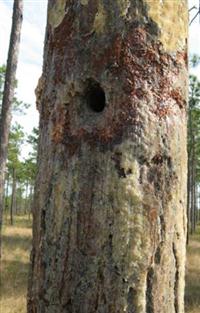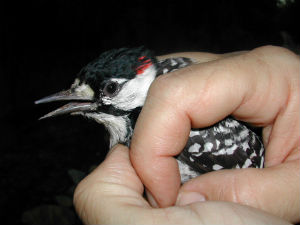First of two parts
HAMPSTEAD — Vic French knows Holly Shelter Game Lands Preserve like the back of his hand.
Supporter Spotlight
The rest of us better have a detailed map, a GPS device and a good compass to take a walk on the wild side in this 65,000-acre biological cornucopia in Pender County.
French, a biologist with the N.C. Wildlife Resources Commission, has been associated with the preserve in various capacities for most of his 30-plus years with the commission.
He’ll tell you upfront that while the commission, governmental agencies and environmental groups play a role in protecting its natural wildness, Mother Nature is very much in charge of its distinct design.

Red-cockaded woodpecker dig nesting cavities in live pine tree. The sap helps protect the nest from predators. Photo: Pam Smith |
Holly Shelter encompasses an expanse of longleaf pine woodlands, savannas, Carolina bays, pocosins and black water streams. Each unique habitat hosts equally unique plant and wildlife, including several threatened or endangered species found exclusively in the state’s southeastern coastal plain.
Supporter Spotlight
Much of the site is remote and inaccessible, but a series of roads are open to the public for hiking, birding, biking and seasonal hunting in designated areas.
The main road into Holly Shelter Game Lands, off U.S. 17 just north of Hampstead, serves as an introduction to the preserve’s varied ecosystem scenarios. An initial tangle of vegetation atop a sandy ridge gives way to a flat, open stretch of golden wire grass dancing in the wind beneath a stand of longleaf pine trees.
Many of the stately longleaf are marked with a pair of painted stripes, indicating active red-cockaded woodpecker cavities – “government housing,” as French jokingly calls them.
About 10 percent of the endangered red-cockaded woodpecker population in southeastern North Carolina nest among the site’s longleaf pines. That’s no accident, French explains. Wildlife biologists follow a prescribed protocol to protect the iconic endangered species that relies on open stands of mature longleaf pines for nesting. At Holly Shelter, specialists conduct periodic controlled burns to maintain suitable habitat.
The controlled burns also promote the regeneration of beneficial plant species that attract other wildlife, including squirrel, quail, snakes and myriad reptiles. Along with native wiregrass, the longleaf pine understory may feature spikes of yucca, bluestem sedge, reed grass, Joe-pye weed and toothache grass. Confederate jasmine, roughleaf loosestrife, goldeneaster or roundheaded lespedeza may add dots and dashes of color.
Gall berry, an evergreen shrub, seems to thrive in a range of Holly Shelter ecosystems. Its tiny sweet-smelling flowers attract honey bees galore. Gall berry honey, French attests, is prized nectar.
Tuesday: A year after The Fire
Species Profile: Red-Cockaded Woodpecker
North Carolina Status: Endangered
U.S. Status: Endangered, listed in October 1970.
Description: About the size of the common cardinal, the red-cockaded woodpecker is approximately 7 inches long (18 to 20 centimeters), with a wingspan of about 15 inches (35 to 38 centimeters). Its back is barred with black and white horizontal stripes. The red-cockaded woodpecker’s most distinguishing feature is a black cap and nape that encircle large white cheek patches. Rarely visible, except perhaps during the breeding season and periods of territorial defense, the male has a small red streak on each side of its black cap called a cockade, hence its name.
 |
The red-cockaded woodpecker feeds primarily on beetles, ants, roaches, caterpillars, wood-boring insects, and spiders, and occasionally fruits and berries.
Range: Historically, this woodpecker’s range extended from Florida to New Jersey and Maryland, as far west as Texas and Oklahoma and inland to Missouri, Kentucky and Tennessee. Today it is estimated that there are about 6,000 groups of red-cockaded woodpeckers, or 15,000 birds from Florida to Virginia and west to southeast Oklahoma and eastern Texas, representing about 1 percent of the woodpecker’s original range. They have been extirpated in New Jersey, Maryland, Tennessee, Missouri and Kentucky.
Life History: Red-cockaded woodpeckers roost and nest in cavities of live pine trees. Cavities are built only in large, old pines. These woodpeckers live in family groups that may include the male and female, their chicks and young adult “helpers.” These “helpers,” typically related young from previous nesting seasons, help build cavities and care for the future chicks. Pecking a cavity in a live tree takes a long time, since the wood is very hard. The birds peck the bark around the entrance to get the sap (resin) flowing around the hole. The sticky sap keeps predators like snakes away from the nest cavity. The birds also eat insects found under the bark and along the branches of pine trees. Females lay two to four eggs during breeding season. A woodpecker group roosts and nests in a cluster of up to 30 cavity trees. Most clusters have some cavities under construction, some completed and in use and some abandoned.
Habitat: Open pine forests with large, widely-spaced older trees provide essential habitat for the red-cockaded woodpecker.
Distribution: The red-cockaded woodpecker can be found in the piney woods of Eastern North Carolina.
Other: Red-cockaded woodpeckers are endangered because the open forests with big, old pine trees have been replaced by forests with younger, smaller pines. Also, periodic natural fires, which historically kept the pinewoods open, have been suppressed since settlement. Periodic fire is needed to control the brushy understory and keep the pinewoods open.








